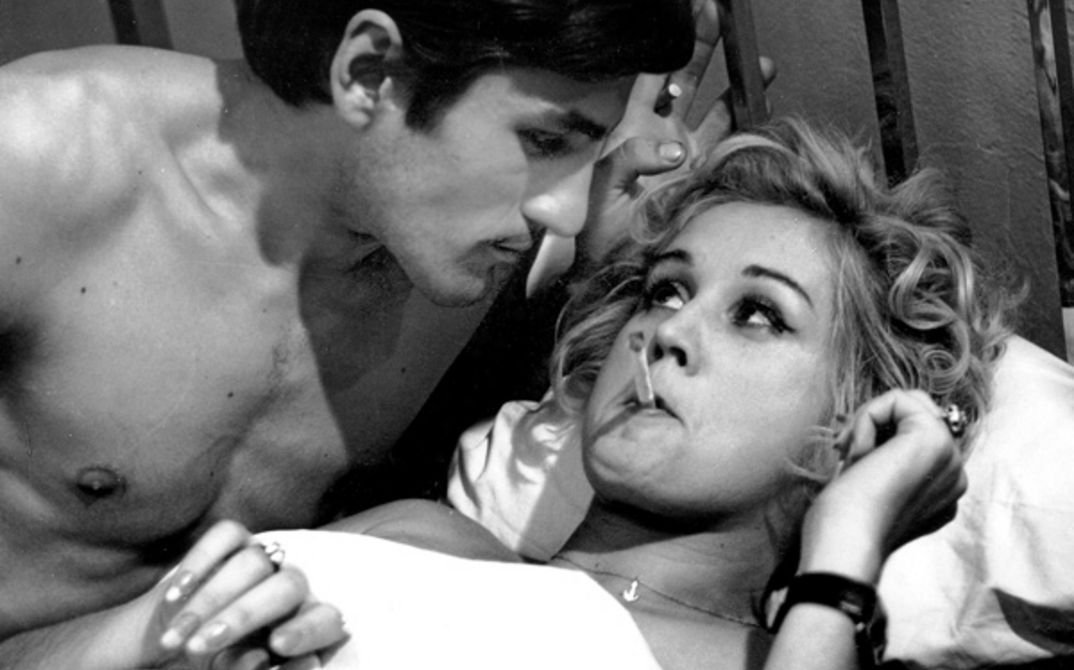A Yugoslav youth
KAD BUDEM MRTAV I BEO tells the story of Janko Bugarski, nicknamed Džimi Barka (Jimmy the Boat), a young man in his twenties who, having no permanent employment or regular living habits, aimlessly wanders around the Serbian province, distinguished by impoverished, dilapidated workers’ settlements, collective farms, and village fairs – all places evocative of harsh living conditions and marked by an overall ‘anti-aesthetic’ visual appearance (ugliness). Centred on its protagonist’s ‘journey through life,’ the film has a loose episodic narrative structure, akin to that of a ‘road movie.’ Jimmy is an ambitionless and disoriented character – in the director’s own words, ‘a man without a compass’ – whose nomadic and, in no small measure, absurd life ends abruptly and in an equally absurd manner: in the film’s memorable final scene, he is shot to death on a toilet. (Arthur Penn is said to have paraphrased this scene in his 1975 film THE MISSOURI BREAKS; John Schlesinger, who saw the film in New York, also claimed that it inspired his MIDNIGHT COWBOY from 1969.)
Jimmy is not particularly representative of the protagonists commonly found in Pavlović’s films and literature (besides being a director, he was also an established novelist, essayist, and author of short stories). (…) Knowing ‘neither what he wants, nor what he does not want’, Jimmy is (…) envisioned as a representative of a state of mind that Pavlović thought widespread among the Yugoslav youth in the mid-1960s (the period preceding the youth uprisings of 1968): an intellectual and moral apathy, an attitude of resignation toward issues of ideology, provoked by an all-out exhaustion of the grand narratives of human emancipation, be they traditional (religion) or modern (Marx).
Yet even if he is disoriented, Jimmy does not lack energy, vitality: the force of life pulsates strongly in him. For film scholar Nebojša Pajkić, this suggests that he is not simply a character without any identity, but a social outcast whose life is a trajectory without a past or a future, a series of intense moments belonging only to the permanent present.
‘Rather a consequence of incidental occurrences’
In the film, Pavlović emphasises this dimension of his character by presenting the viewer with a succession of scenes typically deprived, in the process of editing, of proper dramatic exposition and resolution – a technique inspired by Jean-Luc Godard’s elliptical approach to narrative in films such as À BOUT DE SOUFFLE (1959). Thus, Jimmy may also be understood as a local, Yugoslav version of Godard’s Michel Poiccard (Jean-Paul Belmondo) or as something of an equivalent of such literary antiheroes as Saul Bellow’s Augie March (“The Adventures of Augie March”) or Jack Kerouac’s Dean Moriarty (“On the Road”). (Critics like Pajkic, Nenad Polimac, and Dinko Tucakovic also praised KAD BUDEM MRTAV I BEO as a work that thematically and narratively anticipated the countercultural developments in the New Hollywood Cinema) (…)
Firmly situated at the forefront of KAD BUDEM MRTAV I BEO’s visual register is the unobtrusive, anti-rhetorically conceived sequence shot, a stylistic device deemed most suitable for tracing the complexities and the ambiguities of the multi-layered pro-filmic reality. Often evocative – in its apparent absence of directorial intervention – of documentarist factography, the film largely realised Pavlović’s (...) ideal of ‘creating atmosphere that will by no means seem arranged, but rather as a consequence of incidental occurrences.’ An acclaimed example of this approach is found in the long panning shot set in a provincial workers’ settlement, depicting Jimmy and an army officer walking by a group of chatting peasants, then crossing paths with some protesting workers (who criticise the building of ‘political factories’), while in the far background a platoon of singing soldiers is on the move, followed by a group of playful children. Also frequently praised by critics is the scene of the singing audition in Belgrade, in which the emerging urban youth culture of the mid-1960s is contrasted with the thus-far depicted culture of provincial Serbia. Featuring the Black Pearls (one of the earliest Yugoslav rock bands), this scene is entirely filmed in the cinéma verité style. In its lengthy opening shot, the camera patiently focuses on the drummer awaiting his cue; once he energetically begins to play, it embarks on a sideways track, revealing the location and introducing other musicians.
Pavlovic’s propensity for integral narration, for the mise-en-scène driven organisation and control of space (…) may be partially attributed to his burgeoning infatuation with Italian neorealist cinema (…) as well as to his admiration of such older masters as Jean Renoir and Carl Theodor Dreyer. Yet Pavlović never considered realism to be a goal unto itself but rather a formal strategy, an instrument, in the service of his cinema’s central objective of confronting the viewer with the ‘drastic’ or ‘raw’ image – an image capable of triggering a powerful visceral reaction, commonly a mixture of shock and disgust.
(Pavle Levi, “The Raw Image”, in: Gal Kirn, Dubravka Sekulić, Žiga Testen (eds.): Surfing the Black. Yugoslav Black Wave Cinema and its Transgressive Moments, Maastricht 2012)
